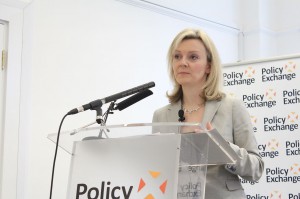This is Lead Week on this blog.
These results are new but they are in line with previous studies – although with higher lead levels.
The Lead Ammunition Group provided a report to government on lead ammunition in early June. That report, which I haven’t seen, must be thick, dry and packed with statistics and information – much of it like these blogs, but written by real experts.
As well as any human health impacts of dietary lead there are nature conservation impacts too. Both aspects are expanded upon in this scientific symposium on lead ammunition.

Government is sitting on that report. Liz Truss – what are you waiting for? Why the delay? When will you publish the report in full? When will you respond to the report?
All of these impacts, on human health and nature conservation, could be avoided by banning lead ammunition – as other jurisdictions have already done (and for similar reasons – they are just years (in the case of Denmark, decades) ahead of us).
A member of the shooting community has set up an e-petition to keep toxic lead ammunition in use – and it is doing rather well. It seems that people who shoot for fun want the rest of us to continue to experience impacts from poisonous lead in our food and in harming our wildlife.
Rob Sheldon has set up an e-petition to call on government to ban toxic lead ammunition and it’s doing OK but not that well. Please sign this e-petition to ban toxic lead ammunition.
[registration_form]
I don’t know if we’ve ever been told if Liz Truss has any qualifications, experience, passion to enable her to do this job well. She’s not like other ministers – the smooth talking, sadistic, spin-doctor bunch.
Ah sorry – about lead shot – a selfish moron has created a petition to allow shooters to continue to contaminate the environment with lead when there are alternatives, I can only assume his brain is addled from eating too much leaded game.
Mike – I think it fair to assume Liz Truss, like most of us, is not qualified to make human health toxicological assessments – but we can read the opinion of those that are – the Food Standards Agency (FSA). They looked at lead in game meat and reported in 2012. I hope this is helpful. Andrew
https://www.food.gov.uk/science/advice-to-frequent-eaters-of-game-shot-with-lead
Andrew – have you discovered the lead content of an infusion of peppermint tea yet? And which day are you going to eat 150g of either sea salt or thyme please? You really should finish what you put on your plate before starting the next course. You are a bit of a messy eater! Just to remind you, and others, this was a hare you started running on blog #10 of this series.
Don’t worry, I will remind you of this.
Andrew – you should look at this – thanks to Tom Cameron for the link
Here is the link to original reference http://www.hindawi.com/journals/jt/2013/370460/ It’s a bit complicated for me.
But what is clear is that the authors are concerned about the levels of lead in tea – especially tea brewed for a long time. And especially for pregnant women.
And this is despite the benefits of some other minerals and metals in tea. So it appears to be another example of a food item to be avoided by some people because of its lead content – I have a feeling that might not have been why Andrew pointed it out. I’ll let him know.
And I can’t immediately get my head around the amounts of lead involved because of the differences in units. I’ll keep looking at it – thank you.
SoS Truss is numerate, an expert on Pork!!, and last week went to a Hampshire GWCT Farmer Cluster to experience their bottom-up approach to soil conservation
The reason the gov is sitting on it is they know how un-popular it will be with their supporters – obviously. The ‘keep the poisonous Lead ammunition’ petition was pretty much stalled on c.22,000. I think Lead week has stimulated it to creep up again!
To buy and eat game is a choice so lets not get too exaggerated about the idea that people are being forces to have lead in their food – the labelling issue is important though.
Re wildlife I still think that the analysis done so far is not the best that could or should be done – that didn’t mean there is no risk – I just dont agree with the wetland risk analysis approach taken.
What I have never seen – and would like to see from the fsa – is relative risk. How can I put these results in perspective. Venison vs processed ham/ sausage, a whole suite of issues come into it from salt, fat, nitrates and in some cases the exercise and wellbeing associated with hunting the venison vs buying the sausage. Anyone looking at this?
Tom
Tom – that’s an uncharacteristically poor comment from you (and that is a back-handed compliment from me).
If lead shot were banned (as it has been in many other places) then there would be just as much game available and it would have praqctically no lead in it. Let’s not lose sight of that fact.
You are welcome to your opinions of course – but you haven’t said what you think is wrong with the wildlife info and so it’s a bit difficult for me or anyone else to comment or believe you or disagree with you.
The analysis you ask for would be rather tricky, I think – don’t you? I’d be very interested to see whether shepherds run around more than dairy farmers and how I should take that into account in my meat purchasing decisions.
Ok I wasn’t being clear enough.
I agree re lead being banned would mean game is available lead free but your wording suggests that to keep lead means the public is forces to experience lead shot game – which of course is not the case. It kind of devalues game to have that scenario – but a few ( c-60%) less pheasant would do no harm.
Re the analysis I do believe I have explained it to you before.
Re the analysis – the benefits including the exercise are to the game consumer who hunted it, not a purchaser of game. Agree that part is difficult – but in terms of relative risks I think that is straightforward for human health and diet experts – and it would be useful.
Sorry but in haste
Tom – you always make more sense to me than Andrew Gilruth does anyway.
Yes you have explained something to me – not much help to all other readers of your comment though.
I will drop in later and explain some of this.
Tom – you are always welcome. You couldn’t tell Andrew Gilruth how much lead there is in pepperment tea too, could you, please?
http://www.womansday.com/health-fitness/wellness/a53159/dangers-of-tea/
Tom – many thanks, I am grateful to you. I’m sure Andrew Gilruth will be too.
Here is the link to original reference http://www.hindawi.com/journals/jt/2013/370460/ It’s a bit complicated for me.
But what is clear is that the authors are concerned about the levels of lead in tea – especially tea brewed for a long time. And especially for pregnant women.
And this is despite the benefits of some other minerals and metals in tea. So it appears to be another example of a food item to be avoided by some people because of its lead content – I have a feeling that might not have been why Andrew pointed it out. I’ll let him know.
And I can’t immediately get my head around the amounts of lead involved because of the differences in units. I’ll keep looking at it – thank you.
I think the lead in different products is probably irrelevant, and its more important to have a fixed max level of heavy metal exposure in all products, either as guidance or legal limit.
My point regarding the wetland analysis is that it is based on a huge extrapolation, and the data on which the extrapolation is based has two problems. Firstly the most recent data is only relevant to a small subset of locations. Secondly the historical data is no longer relevant both the law and user behaviour have changed but the effect on shot deposition has not been measured. In candid private conversation waterfowl biologists acknowledge this – I increasingly do not understand why new data has not been collected. Now this complaint only applies to the wetland analysis – terrestrial use of lead shot is widespread.
Regarding health risks we often hear of the risks to eating processed meats, too much wine, freshwater fish and sugar. These risks come with probabilities – I don’t see why we cant hear of the relative risks to health from replacing other meats with game or vice versa. We don’t ban eating freshwater fish or sausage – we present the risk.
As I keep saying – I have no vested interest in loosing lead – I already hunt without it. I just think these are valid questions
Tom – that was quick! Thank you.
There is no agreed safe lead level – the FSA. Note, there used to be one, but it was done away with on the basis of more evidence. Therefore, it is very useful to know how much lead is in different foodstuffs – as it is to know how much alcohol in different drinks, salt in different foods etc. And Vitamins too – not just ‘bad’ things. Different ‘good’ and ‘bad’ things will be of more or less interest to different groups of people on the basis of health, gender age etc. For example, I am not a kid and am never going to be a pregnant woman.
Your second point is a fair one – although the lack of more recent data is hardly the fault of the researchers who have used the most up to date information available. There is no suggestion that they have used ‘old’ data when there are good ‘new’ data available, is there? I’ve certainly never heard so. Isn’t it striking that all the science on these subjects has been done by conservation biologists – not by the polluters, those responsible, the shooting industry? The likes of BASC and the Countryside Alliance have brought nothing serious to this debate for a long time; their role is to snipe at the people who have done all the hard and expensive work. Even those data on % of BASC members’ eating more than one lead meal a week were only dislodged from BASC after asking repeatedly over a long period of time – I know, I asked for them at several LAG meetings.
Your final point is fair too – but if we simply used non-toxic shot, as you do, then it would be moot. It’s not the food – it’s the stuff shot into it.
Thank you for being a thoughtful commenter.
And yes I agree on shooting industry responsibilities too – on one hand I am disappointed BASC has not done more proactive research on this. But I also wonder wether Debbie et al knows deep down that to redo UK exposure work might act against their objective. Or is it principles, or cashflow? We will find out the new picture soon enough
T